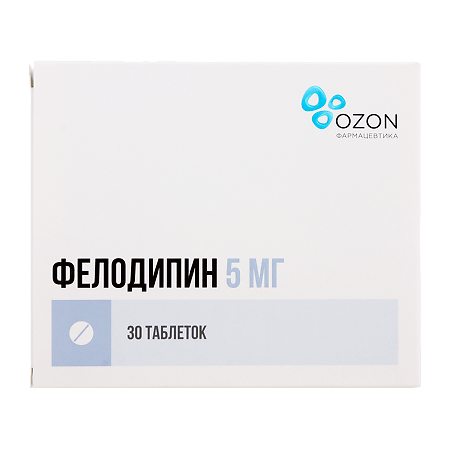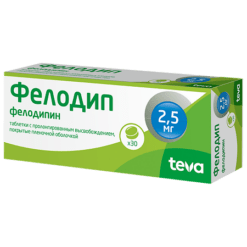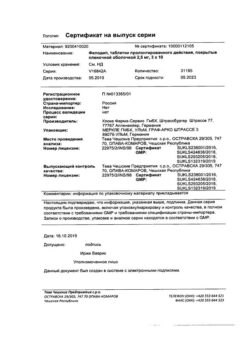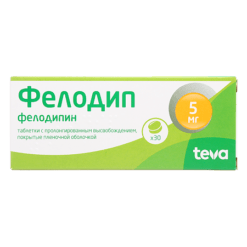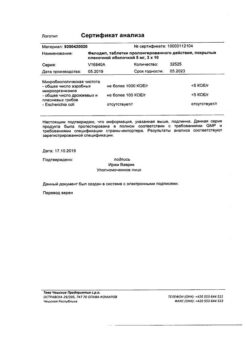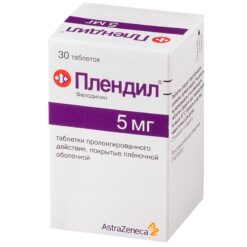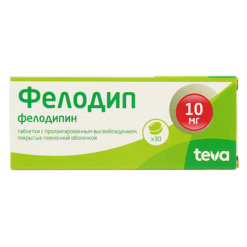No products in the cart.
Felodipine, 5 mg 30 pcs
€10.33 €9.04
Description
Pharmacotherapeutic group
Slow calcium channel blocker
ATX code
C08CA02
Pharmacodynamics:
Felodipine is a slow calcium channel blocker (SCB) used to treat arterial hypertension and stable angina.
Felodipine, a dihydropyridine derivative, is a racemic mixture. Felodipine reduces blood pressure (BP) by reducing total peripheral vascular resistance especially in the arterioles.
The conductivity and contractility of vascular smooth muscle is inhibited by acting on calcium channels of cell membranes.
Felodipine at therapeutic doses has no adverse inotropic effect on cardiac contractility or conduction due to its high selectivity for arteriolar smooth muscle.
Felodipine relaxes the smooth muscles of the airways.
Felodipine has been shown to have little effect on gastrointestinal motility.
Felodipine has no clinically significant effect on blood lipid concentrations with long-term use.
In patients with type 2 diabetes mellitus when using felodipine for 6 months there were no clinically significant effects on metabolic processes.
Felodipine may also be indicated in patients with reduced left ventricular function receiving standard therapy and in patients with bronchial asthma, diabetes, gout, or hyperlipidemia.
Antihypertensive effect: Decrease in BP when taking felodipine is due to decrease in peripheral vascular resistance. Felodipine effectively decreases BP in patients with arterial hypertension when lying down as well as when sitting and standing at rest and during physical activity. Since felodipine has no effect on venous smooth muscle or adrenergic vasomotor control, there is no development of orthostatic hypotension.
At the beginning of treatment, a temporary reflex increase in heart rate (HR) and cardiac output may be observed as a result of BP reduction with felodipine administration. Concurrent use of beta-adrenoblockers with felodipine prevents HR increase.
The effects of felodipine on BP and peripheral vascular resistance correlate with the plasma concentration of felodipine. At equilibrium, the clinical effect is maintained between doses and the BP reduction persists for 24 h.
Felodipine treatment results in regression of left ventricular hypertrophy.
Felodipine has a natriuretic and diuretic effect and no potassium effect. Taking felodipine reduces tubular reabsorption of sodium and water, which explains the absence of salt and fluid retention in the body.
Felodipine reduces vascular resistance in the kidneys and increases renal perfusion. Felodipine has no effect on glomerular filtration rate and albumin excretion.
The use of felodipine in combination with angiotensin-converting enzyme inhibitors (ACE) beta-adrenoblockers and, if necessary, with diuretics reduces diastolic BP below 90 mmHg in 93% of patients.
The use of dihydropyridine derivative DMARDs as initial therapy followed by the addition of beta-adreno-blockers if necessary has no effect on cardiovascular mortality compared to standard therapy with beta-adreno-blockers and/or diuretics.
Felodipine may be used in monotherapy or in combination with other hypotensive medications such as beta-adrenoblockers diuretics or ACE inhibitors to treat arterial hypertension.
Anti-ischemic effect: use of felodipine leads to improvement of myocardial blood supply due to dilatation of coronary vessels. Decrease of cardiac load is provided due to decrease of peripheral vascular resistance (decrease of load overcome by heart muscle) which leads to decrease of myocardial oxygen demand.
Felodipine reduces coronary vasospasm and improves contractility and reduces the frequency of angina attacks in patients with stable angina pectoris. At the beginning of therapy, a temporary increase in HR may be observed, which is stopped by prescription of beta-adrenoblockers. The effect occurs after 2 hours and lasts for 24 hours. For treatment of stable angina pectoris felodipine may be used in combination with beta-adrenoblockers or in monotherapy.
Pharmacokinetics:
The systemic bioavailability of felodipine is approximately 15% and is independent of the time of ingestion. However, the rate of absorption but not its degree may vary depending on the time of ingestion and the maximum plasma concentration is thus increased by approximately 65%.
The maximum plasma concentration is reached after 3-5 hours. The drug is 99% bound to plasma proteins. Volume of distribution in equilibrium state is 10 l/kg.
The elimination half-life is about 25 h the plateau phase is reached within about 5 days. It does not cumulate even with prolonged administration. Total plasma clearance averages 1200 ml/min.
Decreased clearance in elderly patients and in patients with decreased liver function leads to increased plasma concentrations of felodipine. However, age-related features only partially explain individual changes in plasma felodipine concentrations.
Felodipine is metabolized in the liver under the action of CYP3A4 isoenzyme all identified metabolites have no vasodilatory effect (hemodynamic activity).
About 70% of the administered dose is excreted as metabolites with the kidneys and the rest is excreted through the intestine. Less than 05% is excreted unchanged by the kidneys.
In impaired renal function the plasma concentration of felodipine does not change, but there is a cumulation of inactive metabolites.
Felodipine is not excreted by hemodialysis.
Indications
Indications
– Arterial hypertension (in monotherapy or in combination with other antihypertensive drugs such as beta-blockers, diuretics or ACE inhibitors).
– Stable angina (in monotherapy or in combination with beta-blockers).
Pharmacological effect
Pharmacological effect
Pharmacotherapeutic group
Blocker of “slow” calcium channels
ATX code
C08CA02
Pharmacodynamics:
Felodipine is a slow calcium channel blocker (SCBC) used to treat arterial hypertension and stable angina.
Felodipine, a dihydropyridine derivative, is a racemic mixture. Felodipine reduces blood pressure (BP) by reducing total peripheral vascular resistance, especially in arterioles.
The conductivity and contractility of vascular smooth muscle is inhibited by affecting the calcium channels of cell membranes.
Due to its high selectivity for arteriole smooth muscle, felodipine in therapeutic doses does not have a negative inotropic effect on cardiac contractility or conduction.
Felodipine relaxes the smooth muscles of the respiratory tract.
Felodipine has been shown to have little effect on gastrointestinal motility.
With long-term use, felodipine does not have a clinically significant effect on blood lipid concentrations.
In patients with type 2 diabetes mellitus, no clinically significant effect on metabolic processes was observed when using felodipine for 6 months.
Felodipine can also be prescribed to patients with reduced left ventricular function receiving standard therapy and patients with bronchial asthma, diabetes mellitus, gout or hyperlipidemia.
Antihypertensive effect: a decrease in blood pressure when taking felodipine is due to a decrease in peripheral vascular resistance. Felodipine effectively reduces blood pressure in patients with arterial hypertension both in the supine, sitting and standing positions at rest and during physical activity. Since felodipine has no effect on venous smooth muscle or adrenergic vasomotor control, orthostatic hypotension does not occur.
At the beginning of treatment, as a result of a decrease in blood pressure while taking felodipine, a temporary reflex increase in heart rate (HR) and cardiac output may be observed. An increase in heart rate is prevented by the simultaneous use of beta-blockers with felodipine.
The effect of felodipine on blood pressure and peripheral vascular resistance correlates with plasma concentrations of felodipine. At steady state, the clinical effect persists between doses and the reduction in blood pressure persists for 24 hours.
Treatment with felodipine leads to regression of left ventricular hypertrophy.
Felodipine has natriuretic and diuretic effects and does not have a kaliuretic effect. When taking felodipine, tubular reabsorption of sodium and water decreases, which explains the absence of salt and fluid retention in the body.
Felodipine reduces vascular resistance in the kidneys and increases renal perfusion. Felodipine has no effect on glomerular filtration rate and albumin excretion.
The use of felodipine in combination with angiotensin-converting enzyme (ACE) inhibitors and beta-blockers, if necessary, diuretics, reduces diastolic blood pressure to less than 90 mm Hg. in 93% of patients.
The use of BMCC dihydropyridine derivatives as an initial course of therapy followed by the addition of beta-blockers if necessary does not affect the mortality rate from cardiovascular diseases compared with standard therapy with beta-blockers and/or diuretics.
For the treatment of arterial hypertension, Felodipine can be used in monotherapy or in combination with other antihypertensive drugs such as beta-blockers, diuretics or ACE inhibitors.
Anti-ischemic effect: the use of felodipine leads to an improvement in blood supply to the myocardium due to dilation of the coronary vessels. Reducing the load on the heart is ensured by reducing peripheral vascular resistance (reducing the load overcome by the heart muscle), which leads to a decrease in myocardial oxygen demand.
Felodipine relieves spasm of coronary vessels, improves contractility and reduces the frequency of angina attacks in patients with stable angina pectoris. At the beginning of therapy, a temporary increase in heart rate may be observed, which can be stopped by the administration of beta-blockers. The effect occurs within 2 hours and lasts for 24 hours. For the treatment of stable angina, felodipine can be used in combination with beta-blockers or in monotherapy.
Pharmacokinetics:
The systemic bioavailability of felodipine is approximately 15% and does not depend on the timing of meals. However, the rate of absorption, but not its extent, may vary depending on the time of food intake and the maximum concentration in the blood plasma thus increases by approximately 65%.
The maximum concentration in the blood plasma is achieved after 3-5 hours. The drug binds to blood plasma proteins by 99%. The volume of distribution at steady state is 10 l/kg.
The half-life is approximately 25 hours and the plateau phase is reached within approximately 5 days. Does not accumulate even with long-term use. The total plasma clearance averages 1200 ml/min.
Reduced clearance in elderly patients and in patients with reduced liver function leads to increased plasma concentrations of felodipine. However, age only partially explains individual changes in plasma concentrations of felodipine.
Felodipine is metabolized in the liver under the action of the CYP3A4 isoenzyme; all identified metabolites do not have a vasodilating effect (hemodynamic activity).
About 70% of the dose taken is excreted in the form of metabolites with the kidneys, the rest through the intestines. Less than 05% is excreted unchanged by the kidneys.
If renal function is impaired, the plasma concentration of felodipine does not change, but accumulation of inactive metabolites is observed.
Felodipine is not eliminated by hemodialysis.
Special instructions
Special instructions
Particular caution is required in the following conditions: aortic stenosis, impaired liver function, severe renal failure (creatinine clearance less than 30 ml/min), heart failure after acute myocardial infarction, arterial hypotension, which can cause myocardial ischemia in predisposed patients.
The effectiveness and safety of felodipine in the treatment of hypertensive crises have not been sufficiently studied.
Felodipine can cause a significant decrease in blood pressure with subsequent development of tachycardia. This may lead to myocardial ischemia in predisposed patients.
The combined use of drugs that induce the CYP3A4 isoenzyme leads to a significant decrease in the concentration of felodipine in the blood plasma and insufficient therapeutic effect from taking the drug (see section “Interaction with other drugs”). Co-administration of such drugs should be avoided.
The simultaneous use of drugs that inhibit the CYP3A4 isoenzyme leads to a significant increase in the concentration of felodipine in the blood plasma, and therefore such combinations should be avoided. Avoid taking the drug with grapefruit juice due to a significant increase in the concentration of felodipine in the blood plasma.
Felodipine is metabolized in the liver; therefore, in patients with impaired liver function, an increase in felodipine plasma concentrations may be observed. In this regard, felodipine should be used with caution in patients with impaired liver function.
Impact on the ability to drive vehicles. Wed and fur.:
When driving vehicles or other mechanisms that require increased attention, the possibility of developing dizziness and weakness while taking the drug should be taken into account. At the beginning of therapy or during the period of increasing the dose, patients should refrain from engaging in potentially hazardous activities that require concentration and speed of psychomotor reactions.
Active ingredient
Active ingredient
Felodipin
Composition
Composition
Active ingredient: felodipine – 5.00 mg.
Excipients: lactose monohydrate (milk sugar) – 93.00 mg; hypromellose – 84.00 mg; macrogol stearate – 4.00 mg; colloidal silicon dioxide – 3.0 mg; magnesium stearate – 1.00 mg.
Shell composition: hypromellose – 2.90 mg; macrogol – 4000 – 0.70 mg; titanium dioxide – 1.33 mg; iron oxide yellow dye – 0.07 mg.
Pregnancy
Pregnancy
Currently, there is insufficient data on the use of felodipine in pregnant women. Based on animal data on impaired fetal development, felodipine should not be administered during pregnancy. Blockers of “slow” calcium channels can inhibit uterine contractions during preterm labor, however, there is insufficient data to support an increase in the duration of physiological labor. There may be a risk of developing fetal hypoxia if the mother has arterial hypotension and a decrease in perfusion in the uterus due to redistribution of blood flow and peripheral vasodilation.
Felodipine passes into breast milk. When a nursing mother takes felodipine in therapeutic doses, only a small amount of the drug passes into breast milk to the baby. Insufficient experience with the use of felodipine by women during lactation does not exclude the risk of exposure to the drug on breastfed children, and therefore it is not recommended to prescribe felodipine to women during lactation. If it is necessary to continue therapy to achieve a clinical effect, you should consider stopping breastfeeding.
Contraindications
Contraindications
– Hypersensitivity to felodipine or other components included in the drug.
– Heart failure in the stage of decompensation.
– Acute myocardial infarction.
– Unstable angina.
– Hemodynamically significant stenosis of the heart valves.
– Hypertrophic obstructive cardiomyopathy.
– Age up to 18 years (efficacy and safety have not been established).
– Lactose intolerance, lactase deficiency, glucose-galactose malabsorption.
– Pregnancy and breastfeeding (see section “Use during pregnancy and breastfeeding”).
With caution:
Aortic stenosis mitral stenosis lability of blood pressure impaired liver function severe renal failure (creatinine clearance less than 30 ml/min) heart failure after acute myocardial infarction old age arterial hypotension (in predisposed patients can cause myocardial ischemia) simultaneous use with inhibitors or inducers of the CYP3A4 isoenzyme.
Side Effects
Side Effects
The most common adverse reactions when taking felodipine include a dose-dependent effect: swelling of the ankles of mild to moderate severity due to the vasodilating properties of felodipine; for this reason, approximately 2% of patients refuse to take the drug.
At the beginning of therapy or when the dose is increased, redness of the face accompanied by “hot flashes”, headache, palpitations, dizziness and weakness may be observed. Usually these reactions are temporary and go away on their own.
There are isolated reports of sleep disturbances, but no connection with felodipine has been established. Cases of hyperplasia of the tongue and gums have been reported after taking felodipine in patients with severe gingivitis/periodontitis. To avoid or reduce this side effect, careful oral hygiene is recommended.
It is believed that hyperglycemia occurs while taking the BMCC group; however, while taking felodipine, hyperglycemia was observed only in isolated cases.
The adverse events presented below are listed in accordance with the damage to organs and organ systems and the frequency of occurrence.
The frequency of occurrence is defined as follows: often (≥1/100); uncommon (≥1/1000 and <1/100); rare (≥1/10000 <1/1000); very rare (<1/10000).
Organs and organ systems
Often
(≥1/100)
Uncommon
(≥1/1000 and <1/100)
Rarely
(≥1/10000 < 1/1000)
Very rarely
(< 1/10000)
Immune system disorders
hypersensitivity reactions
Endocrine system disorders
hyperglycemia
Nervous system disorders
headache
paresthesia dizziness
fainting
Heart disorders
tachycardia palpitations
extrasystole
Vascular disorders
redness of the face accompanied by hot flashes swelling of the ankles
a pronounced decrease in blood pressure accompanied by tachycardia, which in sensitive patients can cause exacerbation of angina pectoris
Gastrointestinal disorders
nausea abdominal pain
vomit
hyperplasia of the mucous membrane of the tongue and gums gingivitis
Disorders of the liver and biliary tract
increased activity of “liver” enzymes in blood serum
Skin and subcutaneous tissue disorders
exanthema itchy skin
hives
photosensitivity angioedema in the form of swelling of the lips or tongue
Musculoskeletal and connective tissue disorders
arthralgia myalgia
Renal and urinary tract disorders
frequent urination
Disorders of the genital organs and breast
impotence/sexual dysfunction
General and administration site disorders
increased fatigue
fever
The cause-and-effect relationship of the following side effects with taking the drug has not been established:
Blood and lymphatic system disorders: anemia;
Mental disorders: depression insomnia anxiety disorders nervousness drowsiness irritability;
Violations of the organ of vision: visual disorders;
Cardiac disorders: myocardial infarction, angina pectoris, arrhythmia;
Vascular disorders: arterial hypotension, syncope;
Respiratory disorders of the chest and mediastinum: pharyngitis, shortness of breath, bronchitis, influenza, sinusitis, nosebleeds;
Gastrointestinal disorders: diarrhea, dry mouth, flatulence;
Skin and subcutaneous tissue disorders: erythema, bruising, leukocytoclastic vasculitis;
Musculoskeletal and connective tissue disorders: arthralgia, back pain, muscle pain, myalgia, pain in the upper and lower extremities;
Renal and urinary tract disorders: polyuria, dysuria;
Disorders of the genital organs and breast: gynecomastia;
General disorders and disorders at the injection site: chest pain, facial swelling, influenza-like syndrome.
Interaction
Interaction
Felodipine is a substrate for the CYP3A4 isoenzyme. Drugs that induce or inhibit the CYP3A4 isoenzyme have a significant effect on the concentration of felodipine in the blood plasma.
Drugs that induce the cytochrome P450 isoenzyme system: phenytoin carbamazepine phenobarbital and rifampicin, as well as St. John’s wort preparations enhance the metabolism of felodipine due to the induction of the cytochrome P450 isoenzyme system.
The combined use of phenytoin, carbamazepine, phenobarbital and rifampicin leads to a decrease in the area under the concentration-time curve (AUC) by 93% and the maximum concentration (Cmax) of felodipine by 82%. Co-administration with inducers of the CYP3A4 isoenzyme should be avoided.
Drugs that inhibit the cytochrome P450 isoenzyme system: azole antifungals (itraconazole, ketoconazole), macrolide antibiotics (for example, erythromycin) and HIV protease inhibitors are inhibitors of the CYP3A4 isoenzyme.
When co-administered with itraconazole, felodipine Cmax increases by 8 times, AUC by 6 times.
When erythromycin is co-administered, the Cmax and AUC of felodipine increases approximately 25-fold.
Co-administration of felodipine and inhibitors of the CYP3A4 isoenzyme should be avoided.
Grapefruit juice inhibits the CYP3A4 isoenzyme. The use of felodipine with grapefruit juice increases the Cmax and AUC of felodipine by approximately 2 times. Concomitant use should be avoided.
Tacrolimus: Felodipine may cause increased plasma concentrations of tacrolimus. During simultaneous use, it is recommended to monitor the concentration of tacrolimus in the blood serum; a dose adjustment of tacrolimus may be required.
Cyclosporine: when cyclosporine and felodipine are co-administered, the Cmax of felodipine increases by 150%, the AUC increases by 60%. However, the effect of felodipine on the pharmacokinetic parameters of cyclosporine is minimal.
Cimetidine: Concomitant use of cimetidine and felodipine increases the Cmax and AUC of felodipine by 55%.
Overdose
Overdose
Toxicity
10 mg of felodipine in a 2-year-old child caused minor intoxication. Felodipine 150–200 mg in a 17-year-old patient and 250 mg in an adult patient resulted in minor to moderate toxicity.
It is likely that felodipine has a more significant effect on the peripheral circulation than on the heart compared to other drugs in this therapeutic group.
Symptoms
In case of overdose, symptoms of intoxication appear 12-16 hours after taking the drug; severe symptoms may occur several days after taking the drug. The following symptoms may be observed: bradycardia (sometimes tachycardia) marked decrease in blood pressure atrioventricular (AV) block I-III degree ventricular extrasystole atrioventricular dissociation asystole ventricular fibrillation; headache dizziness disturbance of consciousness (or coma) convulsions; shortness of breath, pulmonary edema (non-cardiogenic) and apnea; in adults, respiratory distress syndrome may develop; acidosis hypokalemia hyperglycemia possible hypocalcemia; facial redness accompanied by hot flashes; hypothermia; nausea and vomiting. In case of overdose, the greatest risk is posed by symptoms from the cardiovascular system.
Treatment
The administration of activated carbon, if necessary, gastric lavage is in some cases effective even at the late stage of intoxication. A specific antidote is calcium preparations.
Important!
Atropine (025-05 mg IV for adults, 10-20 mcg/kg for children) should be given before gastric lavage (due to the risk of vagus nerve stimulation).
ECG monitoring.
If necessary, ensure airway patency and adequate ventilation of the lungs.
Correction of the acid-base status and electrolytes of blood serum is indicated.
In case of bradycardia and AV blockade, atropine 05-1 mg IV is prescribed for adults (20-50 mcg/kg for children); the administration is repeated if necessary, or isoprenaline 005-01 mcg/kg/min is initially administered.
In case of acute intoxication at an early stage, it may be necessary to install an artificial pacemaker.
A pronounced decrease in blood pressure is corrected by intravenous administration of fluid; for adults, a solution of calcium gluconate (9 mg Ca/ml) 20-30 ml is administered intravenously over 5 minutes or as an infusion (3-5 mg Ca/kg for children); if necessary, the administration is repeated in the same dose. If necessary, epinephrine (adrenaline) or dopamine is infused.
Cardiac arrest due to an overdose may require resuscitation for several hours.
For convulsions, diazepam is prescribed.
Other symptomatic treatment is carried out.
Storage conditions
Storage conditions
In a place protected from light at a temperature not exceeding 25 ° C.
Keep out of the reach of children.
Shelf life
Shelf life
3 years.
Do not use after expiration date.
Manufacturer
Manufacturer
Ozon, Russia
Additional information
| Shelf life | 3 years. Do not use after the expiration date. |
|---|---|
| Conditions of storage | In the dark place at a temperature not exceeding 25 °С. Store out of the reach of children. |
| Manufacturer | Ozon, Russia |
| Medication form | sustained release tablets |
| Brand | Ozon |
Other forms…
Related products
Buy Felodipine, 5 mg 30 pcs with delivery to USA, UK, Europe and over 120 other countries.

